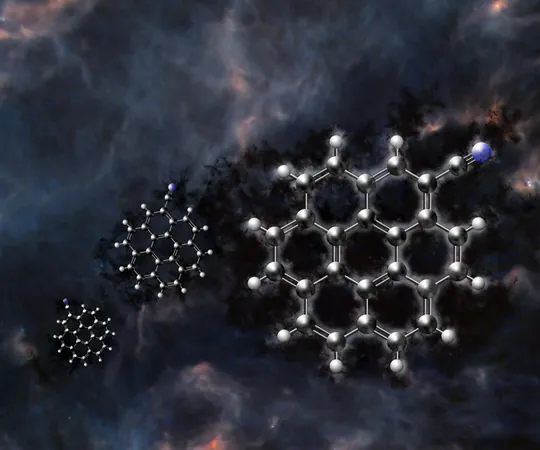
Astronomical Discovery: Giant Aromatic Molecule Unveiled in Deep Space!
2025-06-09
Author: Charlotte
A Groundbreaking Cosmic Revelation
Prepare to be amazed! In a stunning advancement in astrochemistry, scientists have identified cyanocoronene—an incredible polycyclic aromatic hydrocarbon (PAH)—as the largest molecule ever discovered in the depths of space. This unique structure, made up of seven benzene rings and a cyano group (C₂₄H₁₁CN), was located in the cold, dark molecular cloud known as TMC-1, a hotspot for stellar birth and complex chemical processes.
What Makes Cyanocoronene So Special?
Cyanocoronene is a heavyweight in the PAH family, building on the foundation laid by its smaller cousin, coronene. Traditionally viewed as the quintessential stable PAH due to its remarkable structure, it was previously thought that only smaller PAHs existed in cosmic realms. This discovery underscores a monumental shift in our understanding of cosmic chemistry!
The Science Behind the Discovery
How did these clever astronomers pinpoint this massive molecule? The research team began by synthesizing cyanocoronene in the lab, meticulously charting its microwave spectrum with cutting-edge spectroscopic methods. This 'molecular fingerprint' led them to comb through data from the U.S. National Science Foundation's Green Bank Telescope, a critical instrument used in the GOTHAM (GBT Observations of TMC-1: Hunting Aromatic Molecules) initiative. Their hard work paid off, revealing distinct spectral lines of cyanocoronene with an impressive statistical significance of 17.3 sigma—an extraordinary feat!
What This Means for Our Understanding of the Universe
Cyanocoronene now holds the title of the largest known individual PAH discovered in interstellar space, boasting 24 carbon atoms in its core structure. Surprisingly, the amounts detected are comparable to those of smaller PAHs, challenging previous notions that size correlates with rarity in the cosmos. This astonishing finding hints that even more complex aromatic molecules could be prevalent throughout the universe.
A Catalyst for Life?
The existence of stable, large PAHs like cyanocoronene raises the prospect that these molecules could serve as vital reservoirs of carbon, providing essential building blocks for life as new planetary systems emerge. Remarkably, research into its quantum chemical properties suggests cyanocoronene can efficiently form in the frigid expanses of space, even before the birth of stars.
Expanding the Cosmic Chemistry Narrative
This monumental find not only enriches our understanding of cosmic chemistry but also supports the PAH hypothesis—that these compounds are responsible for certain elusive infrared emissions observed across the universe. Additionally, it draws connections between the organic molecules present in meteorites, asteroids, and interstellar clouds, indicating that the organic material found in our solar system may trace its origins back to similar celestial environments.
The Future of Cosmic Exploration
Scientists are eager to search for even larger PAHs and to explore the resilience and evolution of these molecules in the harsh conditions of space. Gabi Wenzel, a Research Scientist from MIT and lead author of the study, passionately states, "Each new detection brings us closer to uncovering the origins of complex organic chemistry in the universe—and perhaps even the origins of life's building blocks!" This thrilling scientific breakthrough was unveiled at the 246th summer meeting of the American Astronomical Society—stay tuned for more cosmic revelations!









 Brasil (PT)
Brasil (PT)
 Canada (EN)
Canada (EN)
 Chile (ES)
Chile (ES)
 Česko (CS)
Česko (CS)
 대한민국 (KO)
대한민국 (KO)
 España (ES)
España (ES)
 France (FR)
France (FR)
 Hong Kong (EN)
Hong Kong (EN)
 Italia (IT)
Italia (IT)
 日本 (JA)
日本 (JA)
 Magyarország (HU)
Magyarország (HU)
 Norge (NO)
Norge (NO)
 Polska (PL)
Polska (PL)
 Schweiz (DE)
Schweiz (DE)
 Singapore (EN)
Singapore (EN)
 Sverige (SV)
Sverige (SV)
 Suomi (FI)
Suomi (FI)
 Türkiye (TR)
Türkiye (TR)
 الإمارات العربية المتحدة (AR)
الإمارات العربية المتحدة (AR)